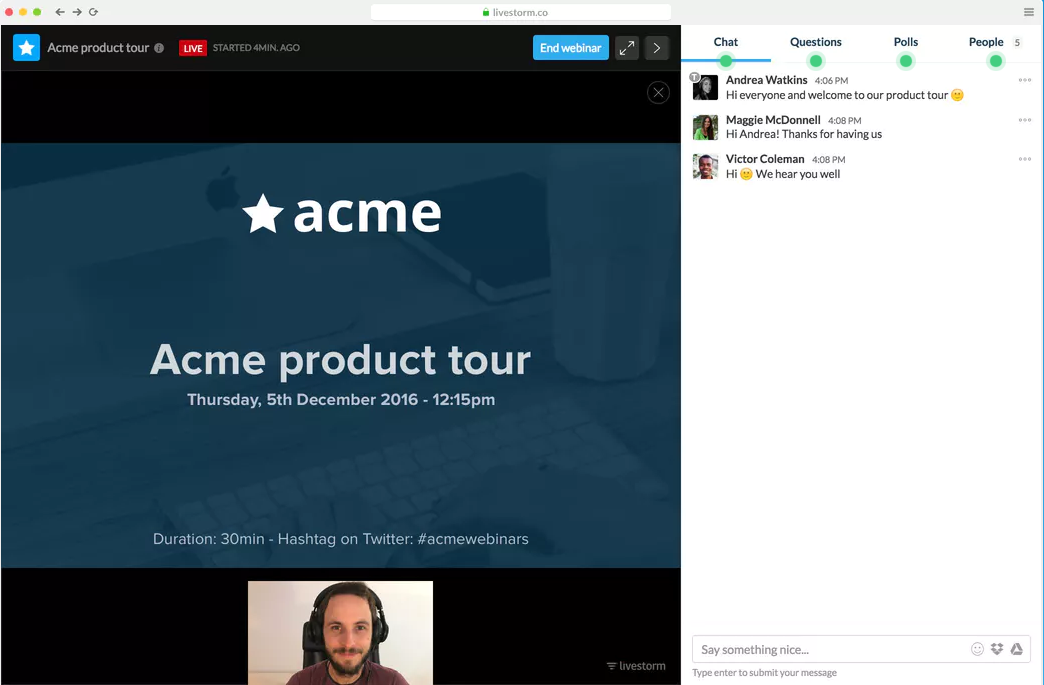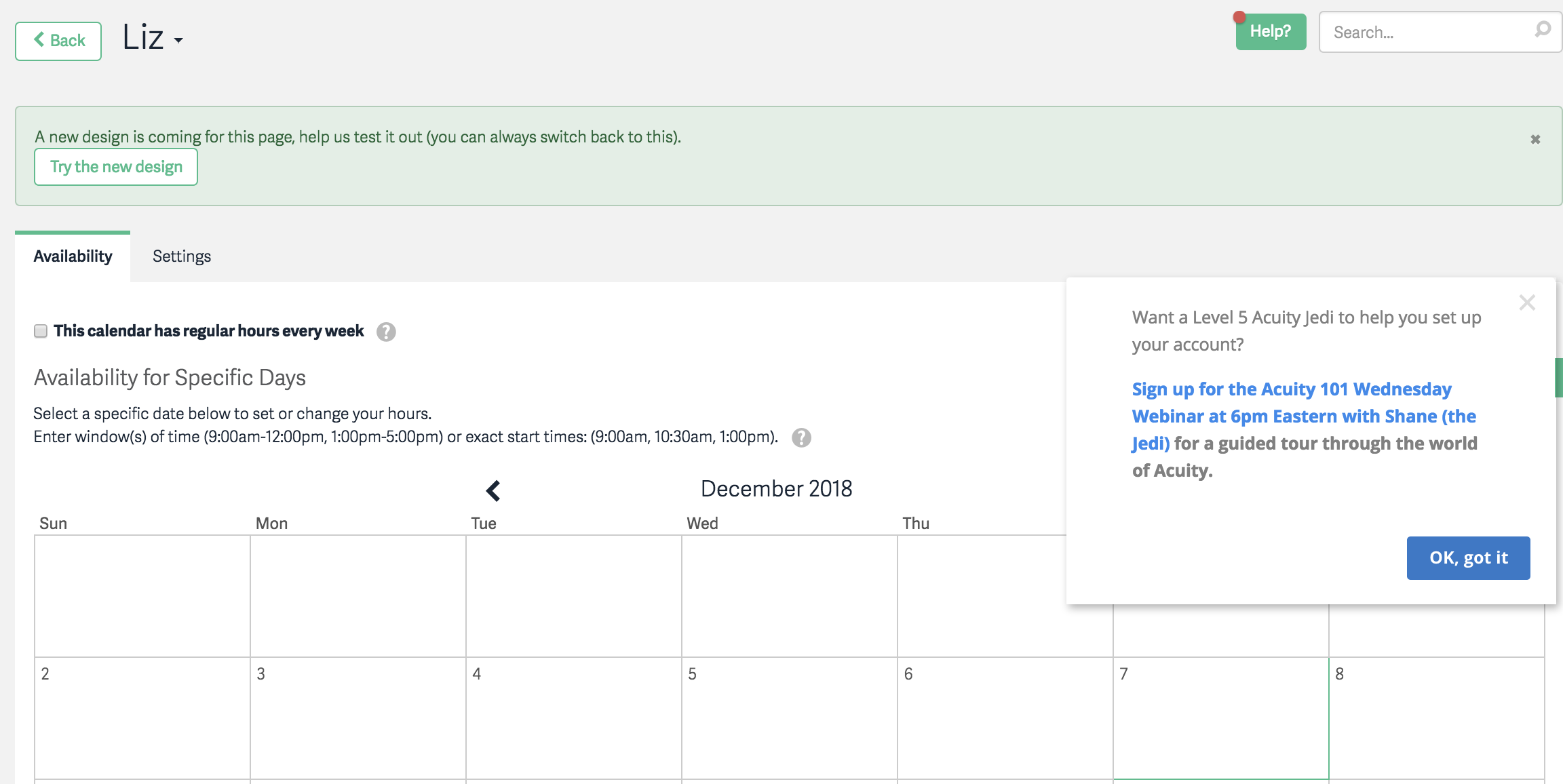Growing a webinar program through trial and error (and Appcues)

.png)

.png)
Let me preface the following by explicitly stating that we (Acuity) by no means have a finished webinar model. It’s not a success story by any means—I like to think of it as success-in-the-making story.
Here’s what I can tell you. Our customers that have attended webinars have left with two takeaways: a sense of who we are—the humans behind the application—and a elevated competency for success in their business with our product.
Yes, this has translated to higher conversions for us and more DAU as the stickiness of Acuity becomes more accessible. But more importantly, we found a way to serve the visual learners, we found a way to serve those that can’t abide by non-instant support, we found a way to serve direct communicators—and we’re doing it in a forum where no questions are off limits and where our quirky Acuity brand can be projected into an interactive space.
I didn’t put much stock in webinars at the beginning (how’s that for advocacy?). The tech out there was clunky; it required users to download and install the service; and generally had too many barriers to entry for our time-crunched, predominantly low-tech audience.
Still, we dove in, aiming to use webinars as an educational tool that would reduce support tickets in our daily inbox and engage our customers. Support is a big line item at Acuity, and one that we are hyperconscious of, so we’re always experimenting with ways to reduce the cost of CS while still providing support that is as fast, accurate, and human as possible.
With license to experiment, we entered into webinars with the vision that any number of webinar attendees meant an equal decline of emails in the inbox.
Our inaugural webinar program went...well, horribly. Among the attendees were a couple parents of employees and a lost internet pilgrim. But we had bet against early success from the outset: Our goals weren’t to hit numbers or drive traffic, but to master the art—and make our support better.

Without support, our product—any product, really—is powerless. In fact, I’d argue that in some ways, support is more vital than the product itself: Support is sales, brand diplomacy, user experience, feature feedback, customer success. It’s a confluence of departments and the key to providing our customers with the confidence and capability to actually use the Acuity product, and use it so well that it becomes a low-maintenance, integral part of their business.
All of this is to say that we emphasize support and encourage experimentation—our support team dedicates a lot of time to the critical thinking and problem solving to make Acuity better and translate those upgrades to our customers. Webinars are one such solution.
As the months passed, our attendee numbers remained constant—around 6 to 10 people per webinar—essentially a side project for our two webinar specialists. However, during that time, our minimum viable product had evolved quite a bit thanks to constant testing and adjusting.
I would highly recommend introducing your webinar program as an MVP with a long-term vision. Like any new strategy or product, you should be prepared to experiment, fail, improve—and iterate on that process many times over.
After our own extended testing phase, we developed some key improvements:
1). Absorb webinar FAQs into the scripts so co-hosts will spend less time answering frequent questions and more time providing answers and covering key topics during the webinar itself.
2). Incorporate the support-development feedback loop, passing feature requests or frustrations along to our development team for them to implement. When applicable, introduce new features during webinars to demonstrate attendee feedback was taken seriously and considered.
3). Use 2 co-hosts for bigger webinars (our number is over 100 registrants) to answer more questions, keep the live chat active and light-hearted, and make the presentation feel more dynamic.
4). We switched to Livestorm, which is still missing some key features, but had it where it counts: no downloads, no installations.

Of course, stakeholders won’t be impressed by how tight your script is or how dynamic your presentation appears if you don’t have results—quanitifiable results—to show for your effort.
To circle back to our brand ethos, we were fast and accurate, but we were lacking the attendee numbers to effectively deliver the human component. It seems strange to qualify humanity as an integral differentiator, but in a world of chatbot funnels and automated replies, the ability to practice empathy and active listening is its own feature—especially when working with small businesses.
The effects of empathy and soft skills are quantifiable through support. Customers that interact with our support team are 9% more likely to be promoters on our NPS. They also convert to paid users as much as 31% more frequently than those that do not interact with our support—even if the interaction was rated as less than desirable.
This is why we pursue webinars: They offer another point of support for your users to fully realize your product’s potential in their business ecosystem. And, as a medium, it’s not explicitly salesy—it’s relationship-building. That is, as long as you can generate attendance.
We used Appcues to increase feature adoption—in our case, webinars. By targeting users in the Acuity app with triggers around our trickier features, or targeting users that hit our help docs, we quickly doubled (sometimes septupled) our traffic.
From there, we tested our targeting, our copy, and how long before the webinar we should display a slideout to maximize our traffic through Appcues (2 weeks is our current sweet spot).

Appcues helped us reach our “oh snap, there’s something here” moment and led us to build out the rest of our stack. After the initial success with Appcues, we quickly added resources to our webinar registration generation. Customer.io now points users to our webinars in the onboarding sequence. Our Facebook groups point to weekly advanced webinars. We announce our specialized webinars in Slack each week so our support team can plug them in pertinent emails.
Now, our webinars have a seat at the table.
Around the same time that we initiated Operation Webinar Liftoff (working title), I attended a talk at the Zoom user conference by Gabe Villamizar from LucidChart on webinar marketing. That talk really influenced how I view webinars within our marketing toolkit.

Some parts of his presentation were pretty general—as any presentation to an unknown audience is bound to be. However, one component of Gabe’s presentation really stuck with me, and I want to pass this to you:
I know, I know. Us SaaS-ers are supposed to be in this post-funnel, Reforge loop world where (in theory) everything you do feeds into the next. But I disagree. Long live the webinar funnel!
Here’s why:
1) Thinking of webinars as a funnel allows us to remove redundant content.
Example: We had two webinars that were covering similar content on account setup. We now have webinars occupying defined spaces in our funnel, which makes targeting a lot easier.
2) Our targeting and segmentation is more focused.
With a progressive webinar experience, we can target users with Customer.io based on which webinars they have attended. We’re also adding webinars to the top (thought leadership) and bottom of the funnel (industry specific training) to give ourselves full coverage and find more ways to funnel users into our onboarding and retention webinars.
3) Thinking about webinars as a funnel allowed us to leverage high-retention users into referrals.
OK, I lied. There is a loop. At Acuity, we close our loop in two ways:
These attendees invite others to attend through their social network or recommend webinars to user questions in our support group.
And so the loop continues.

Acuity has embraced webinars because they help us deliver support that is fast, accurate, and human.
For our users, the human element is essential. We work with businesses that are often a small story in a sea of competing brands. Webinars not only give these users a forum to voice their needs, but it helps them connect with other users from all over the world that are going through the same small business struggles.
And that’s empowering.

Equally essential to our customers is respect—fast and accurate responses show respect.
This is why our more experienced support folks are the ones who take on webinars—they have such a strong grasp of how our product can fit into any ecosystem and can answer webinar questions quickly and accurately. By being fast and accurate, they respect our customer’s time, which is finite in the small business world. And they know when to tell a customer that we are a bad fit for their business, going so far as to recommend similar products that fit their business model better. This, too, is respect.
Lastly, webinars make us accessible. Fast isn’t only measured by how quickly we can respond to a customer with a need. Fast is also how accessible answers are to the customer. Webinars are a format that caters to the visual learner, to those that don’t want to go through email support channels. Without webinars, we would be under-serving our community.
I’m by no means advocating webinars as a support panacea. They can be a huge time and resource investment, and the payoff isn’t easily measured.
But if you believe that customer support is at the heart of your business’ success, webinars are an excellent step on your road to better serving your customers.